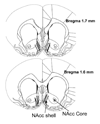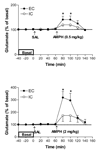Environmental enrichment increases amphetamine-induced glutamate neurotransmission in the nucleus accumbens: a neurochemical study
- PMID: 18242591
- PMCID: PMC2293327
- DOI: 10.1016/j.brainres.2007.12.052
Environmental enrichment increases amphetamine-induced glutamate neurotransmission in the nucleus accumbens: a neurochemical study
Abstract
In addition to dopamine (DA), evidence indicates that glutamatergic regulation of the mesolimbic reward pathway is involved in mediating the abuse-related effects of psychostimulants, including amphetamine. Since rats raised in an enrichment condition (EC) during development are more sensitive to the locomotor stimulant effects of acute amphetamine compared to rats raised in an impoverished condition (IC), the present study examined amphetamine-induced extracellullar glutamate and aspartate levels in the nucleus accumbens (NAcc) of EC and IC rats using in vivo microdialysis coupled with HPLC-electrochemical detection. Basal extracellular levels of glutamate or aspartate were not significantly different between EC and IC rats. Acute systemic amphetamine (0.5 or 2.0 mg/kg, sc) increased extracellular glutamate levels in NAcc of EC rats (137% or 305% of basal) and IC rats (120% or 187% of basal). Similarly, acute systemic amphetamine (0.5 or 2.0 mg/kg, sc) elevated aspartate levels in NAcc of EC rats (148% or 237% of basal) and IC rats (115% or 170% of basal). Glutamate levels were elevated by amphetamine to a greater extent in EC rats than in IC rats. Pretreatment with systemic MK-801 (0.25 mg/kg, ip), a non-competitive N-methyl-d-aspartate (NMDA) receptor antagonist, prevented the acute amphetamine-induced increase in extracellular glutamate and aspartate levels in NAcc. Overall, these results suggest that alterations in glutamate in the NAcc may be involved in the environment-dependent effects of amphetamine.
Figures




Similar articles
-
Effect of environmental enrichment on dopamine and serotonin transporters and glutamate neurotransmission in medial prefrontal and orbitofrontal cortex.Brain Res. 2015 Mar 2;1599:115-25. doi: 10.1016/j.brainres.2014.12.034. Epub 2014 Dec 20. Brain Res. 2015. PMID: 25536304 Free PMC article.
-
Acute and repeated systemic amphetamine administration: effects on extracellular glutamate, aspartate, and serine levels in rat ventral tegmental area and nucleus accumbens.J Neurochem. 1996 Jul;67(1):352-63. doi: 10.1046/j.1471-4159.1996.67010352.x. J Neurochem. 1996. PMID: 8667013
-
2-Chloro-N-[(S)-phenyl [(2S)-piperidin-2-yl] methyl]-3-trifluoromethyl benzamide, monohydrochloride, an inhibitor of the glycine transporter type 1, increases evoked-dopamine release in the rat nucleus accumbens in vivo via an enhanced glutamatergic neurotransmission.Neuroscience. 2006;137(2):555-64. doi: 10.1016/j.neuroscience.2005.09.003. Epub 2005 Nov 14. Neuroscience. 2006. PMID: 16289893
-
Maladaptive consequences of repeated intermittent exposure to uncertainty.Prog Neuropsychopharmacol Biol Psychiatry. 2020 Apr 20;99:109864. doi: 10.1016/j.pnpbp.2020.109864. Epub 2020 Jan 15. Prog Neuropsychopharmacol Biol Psychiatry. 2020. PMID: 31952958 Free PMC article. Review.
-
Regulation of synaptic transmission by ambient extracellular glutamate.Neuroscientist. 2008 Apr;14(2):171-81. doi: 10.1177/1073858407308518. Epub 2007 Oct 18. Neuroscientist. 2008. PMID: 17947494 Free PMC article. Review.
Cited by
-
Effect of environmental enrichment on dopamine and serotonin transporters and glutamate neurotransmission in medial prefrontal and orbitofrontal cortex.Brain Res. 2015 Mar 2;1599:115-25. doi: 10.1016/j.brainres.2014.12.034. Epub 2014 Dec 20. Brain Res. 2015. PMID: 25536304 Free PMC article.
-
Have studies of the developmental regulation of behavioral phenotypes revealed the mechanisms of gene-environment interactions?Physiol Behav. 2012 Dec 5;107(5):623-40. doi: 10.1016/j.physbeh.2012.05.014. Epub 2012 May 27. Physiol Behav. 2012. PMID: 22643448 Free PMC article. Review.
-
The effects of mGluR2/3 activation on acute and repeated amphetamine-induced locomotor activity in differentially reared male rats.Exp Clin Psychopharmacol. 2014 Jun;22(3):257-65. doi: 10.1037/a0035273. Epub 2014 Jan 27. Exp Clin Psychopharmacol. 2014. PMID: 24467371 Free PMC article.
-
Effect of environmental enrichment on methylphenidate-induced locomotion and dopamine transporter dynamics.Behav Brain Res. 2011 May 16;219(1):98-107. doi: 10.1016/j.bbr.2011.01.001. Epub 2011 Jan 8. Behav Brain Res. 2011. PMID: 21219939 Free PMC article.
-
Environmental enrichment and a selective metabotropic glutamate receptor2/3 (mGluR2/3) agonist suppress amphetamine self-administration: Characterizing baseline differences.Pharmacol Biochem Behav. 2020 May;192:172907. doi: 10.1016/j.pbb.2020.172907. Epub 2020 Mar 13. Pharmacol Biochem Behav. 2020. PMID: 32179027 Free PMC article.
References
-
- Bardo MT, Bowling SL, Rowlett JK, Manderscheid P, Buxton ST, Dwoskin LP. Environmental enrichment attenuates locomotor sensitization, but not in vitro dopamine release, induced by amphetamine. Pharmacol. Biochem. Behav. 1995;51:397–405. - PubMed
-
- Bardo MT, Klebaur JE, Valone JM, Deaton C. Environmental enrichment decreases intravenous self-administration of amphetamine in female and male rats. Psychopharmacology. 2001;155:278–284. - PubMed
-
- Bardo MT, Valone JM, Robinet PM, Shaw WB, Dwoskin LP. Environmental enrichment enhances the stimulant effect of intravenous amphetamine search for a cellular mechanism in the nucleus accumbens. Psychobiology. 1999;27:292–299.
-
- Bowling SL, Bardo MT. Locomotor and rewarding effects of amphetamine in enriched, social, and isolate reared rats. Pharmacol. Biochem. Behav. 1994;48:459–464. - PubMed
-
- Bowling SL, Rowlet JK, Bardo MT. The effects of environmental enrichment on amphetamine-stimulated locomotor activity, dopamine synthesis and dopamine release. Neuropharmacology. 1993;32:885–893. - PubMed
Publication types
MeSH terms
Substances
Grants and funding
LinkOut - more resources
Full Text Sources

